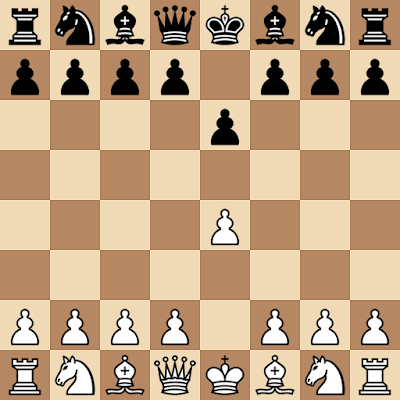How To Play the French Defense
The French Defense is as uptight and difficult to work with as what it's named after. Kidding aside, the French Defense is not something you should try playing on a whim because despite its seemingly solid defenses, one can easily go wrong with this opening. However, whenever I've played this on the White side, I can't seem to shake the feeling that it annoys me, every time. I've tried to learn the basics of the French on either side but as White, being the tactically inclined player that I am, I just get the urge to try and break down Black's pawn structure right away which leads to complications and finally to a loss.
Anyway, the basic move is as shown above. In response to White's e4, Black plays e6, not completely committing to the center but also preparing to meet White's central pawns with an opposing force of his own. However, the difference between this and e4-e5 is that White grabs space and Black gets themselves in a cramped spot. Not always a bad thing, but for someone like me who tends to panic in cramped spaces, it's not a good prospect. Usually, Black tries to develop on the queenside while White should probably attack on the kingside. The problem with this is that the direction or focus of the action is on the queenside. You'll figure that out once you trace the direction where the pawns are going and they are pointing toward the queenside.
White isn't completely at a disadvantage though as I have probably made it out to be. That's not the case. White actually has a lot to work with especially with the space advantage. Just be careful about Black's advances because it might catch you by surprise if you don't know what he's trying to do. And what Black is trying to do is to break down White's center. It's obvious with the moves c5 and f6 later on but before that, Black will try to develop all of his pieces aiming at the center, trying to undermine it by any means necessary, because technically that's the only option. This actually makes the game easier to play for Black. So if White can neutralize Black's plan and come out with an equal position out of the opening, then they're all set.
As I've said, I've mostly played against the French Defense because it's not my thing. And it's rarely played nowadays based on the games I've had. Though that could give someone a leg up if they plan on studying and mastering this opening. Furthermore, it doesn't only work for e4. You can play e6 even against d4 or even c4 and still come out with a good position from the opening. It's a flexible first move for Black is what I'm saying. Not that I haven't played this from the Black side, I have and the few games in which I played this opening, I was able to get a solid position and a nice game. I don't really remember the result, there were probably some losses there as well but I've had comfortable positions playing the French. The only caveat again for Black is that they would have the tendency to be caught gasping for air if they aren't careful. Other than that, it's a nice opening to play in casual games. It's rarely played in top-level chess because it's just not as great at equalizing or making complications as the Ruy Lopez for example. Nonetheless, it's a good opening.



Comments
Post a Comment